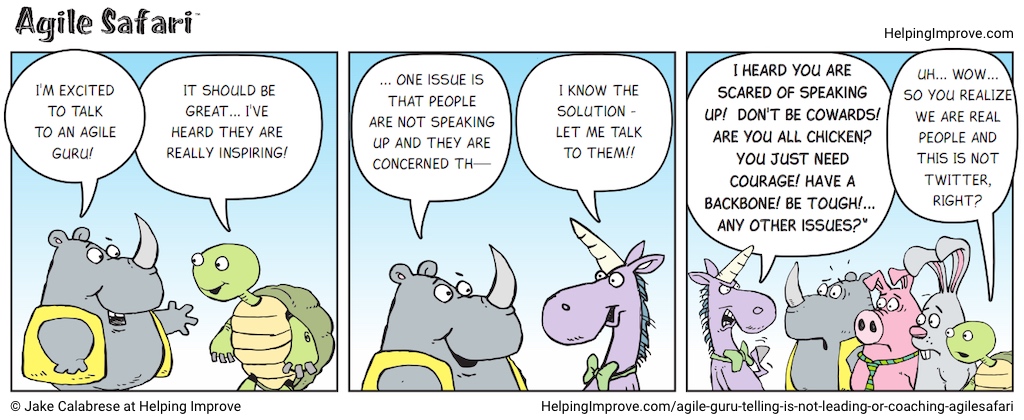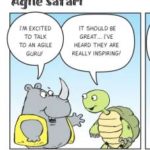
Tweet the Agile Safari Cartoon!
Too often advice gets boiled down to a one-liner. We see these a lot on slide decks, on Twitter, and in news headlines. Does simply telling a team to “have courage” help?
“Be tough.” “Have courage.” “Get a backbone.” Sure these approaches might help a few, but if that is the extent of your help, you might want to consider another line of work.
I’m left wondering if people trying this approach just lack empathy and are not willing to engage at the level required to understand what is really happening — so they fall back on this 1950’s bulls##t of “toughen up.”
Your lack of compassion does not mean someone doesn’t have a backbone.
-End Rant-
A “Bit” Harsh?
So you might be wondering, “where is my empathy for these folks who are telling people to just grow a spine?” That is a fair question!
That first part is a bit harsh. Perhaps you are just busy or simply tired of hearing the same complaint from people. I get that, I get tired of hearing what appear to be the same excuses myself. It can be EXHAUSTING! However, we really don’t know what is going on — what is causing this person or team to not speak up — without engaging with them.
What is your goal?
What is your goal for helping a person, team, or organization? You want to start with an assessment and a decision.
You need to assess if you have the time, patience, interest, and passion to engage at the level required.
Then, you need to decide if you want to attempt to help.
Ability certainly comes into play here. If you do ask people to dig in, are you prepared for what may occur? What if someone gets upset? Storms out? Cries? Are you prepared to deal with truth? The underbelly of the issue?
The assessment and decision are not trivial. You need to think about if this is something that is valuable to you. Is it something that you really and truly want to do? That is where the passion will kick in, or not.
Leading and Coaching
As a leader or agile coach — what can you do to help people without simplistic recommendations?
- Work on yourself — your ability to check your ego and engage with the person, team, or system to help them crucial. This is not about you, it is about them. Who’s agenda are you working from?
- Look at people in a different way — To be very clear, I don’t find any of this simple. I like to rant about things as much as the next person (maybe more!), but there is a difference when you decide to engage with people in way that is helpful to them. It can be one of the most challenging things we choose to do. And the most rewarding. Can you see the other sides of people?
A short story
You take a lunch break. You grab lunch and a bottle for later. You end up sitting in your car staring at the bottle. The next thing you know, you have chugged the entire thing! What was in the bottle? It was not vodka or rum. Instead it was a 120 proof curiosity. You figure you better head back to the office, being curious what the day will bring.
You head to your next meeting, a retrospective. No one is talking. The facilitator keeps asking what appears to be high-quality powerful questions. Yet no one is responding. The energy in the room is off. Your instinct to tell people how the retrospective is supposed to work is subdued by the curiosity sauce. You wonder, does this team lack courage? Maybe a lecture on Scrum values would help — although the curiosity quickly puts that out of your mind.
You start wondering about other things, like what is preventing people from speaking up? Do they feel unsafe? What would happen if they changed just one thing? You start thinking of a number of different ways you can engage with them. Should you even engage? How will the facilitator handle things? How will the facilitator react if you. . .
Before you get any farther, the facilitator sits down heavily. She takes a long breath and looks around the room. You feel the energy in the room tighten. Then she leans back and says “let’s forget about the retro — I’m curious about how each of you is doing. And how you are feeling. I know it’s been a really stressful month. I know I’ve been feeling it. . . So how are you doing?” She is asking this from a place of genuine interest.
There is quiet. And a pause — what seems like a long time before someone speaks — but its only about 10 seconds. The first person starts and just says they are exhausted and really can’t even think about improving anything. Then another person adds to that, and more people chime in. Perhaps the facilitator had a bottle of curiosity too — she listened to ‘what’ was happening in the room and when her plan was not working, she tried something different to engage the team instead of just telling them to have courage and speak up.
As people talk about where they are, the room changes. You get a shared sense of relief. People can actually just talk about the reality of what has been happening without a focus on the next step of a retrospective process.
Later that day as you are leaving the office you wonder about the power of curiosity and it’s limits. As you are driving home someone cuts you off. Do you beep? Gesture? Do you talk out loud to yourself about what their problem is? Mumble under your breath? Strangely, you don’t do any of these things. Instead the curiosity has you wondering how they are. How is their day. What happened to them that is causing them to ignore everything going on around them? As you arrive home and park, you think “I hope they have a better day.” Then you wonder if it is the sauce talking.
The end.
Next?
What happens next may vary — I’ve worked with teams who just end things at a point like this, with the facilitator recognizing that this is the current capacity (different than ability) of the team. In others cases, I have had this type of situation then lead into an in-depth retrospective (or session).
You can’t mandate courage.
Explore ways to be curious! Explore the levels of curiosity! Being truly curious is not just wondering at an intellectual level, it is going deeper and asking what is happening with people and how it is affecting them. It is easy? Certainly not. It is amazingly rewarding when you can help people shift or breakthrough to a new level. That is the stuff that keeps me learning and engaging.
Helping people to learn, be curious, and engage is a large part of our motivation in building a new course for leaders, managers, and agile coaches. The class, Agile Leadership, is focused on helping teams reach and maintain high performance. Tricia Broderick and I developed this course based on years of experience working with organizations, teams, and individuals. The course digs into these challenges and much more including a coaching engagement model, embracing healthy conflict, and critically, we explore real scenarios! Check out the course and let us know if you have questions.
Thoughts on the article? Comments? Fire away!









“You need to think about if this is something that is valuable to you. Is it something that you really and truly want to do? That is where the passion will kick in, or not.”
I think when one makes this choice to approach, take time to discuss an issue with curiosity, rather than with an assumption or one’s own personal story, empathy might kick in. However, many factors are in play, such as one’s personality and character.
Taking the time makes me think of AIWATT:
Am I willing
At this time
To Make the investment required
To mak a positive difference
On this topic?
~ Marshall Goldsmith
Yeah, yeah, I know, I reading this almost a year later! 😉